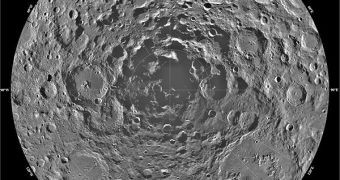A group of investigators proposes that the craters located at the lunar poles may be charged to hundred of volts, due to the effects of solar winds flowing above. The streams of charged particles slam into the natural obstructions produced by the edges of craters, triggering the phenomenon.
The new calculations were produced by a science team at the NASA Lunar Science Institute (LSI). The team analyzed these regions because they hold great promise for future space explorers and astronauts.
Studies have demonstrated that the lunar south pole features permanently-shadowed craters, which contain vast supplies of water-ice. The substance will be extremely useful for crews visiting the Moon.
In addition to drinking water, the water-ice deposits may also provide oxygen for living modules, as well as fuel for rockets. Carrying all these resources from Earth would be financially and technologically unfeasible, Daily Galaxy reports.
Temperatures inside these special craters can reach minus 400 degrees Fahrenheit. This means that water trapped inside is as hard as granite. Exploiting it would require its own technological progress.
“However, our research suggests that, in addition to the wicked cold, explorers and robots at the bottoms of polar lunar craters may have to contend with a complex electrical environment as well, which can affect surface chemistry, static discharge, and dust cling,” William Farrell explains.
The expert is based at the NASA Goddard Space Flight Center (GSFC), in Greenbelt, Maryland. The flow of solar winds above these regions was analyzed using an advanced computer simulation.
Knowing such things about prospective landing sites is extremely important, especially considering the frailty and vulnerability of spacecraft. Static discharges could easily compromise sensitive electronic equipment, endangering the lives of astronauts, and the success of their mission.
If lunar dust is electrically charged, then it adheres to surfaces extremely well. This means that it could penetrate spacecraft, and enter space explorers' lungs, causing disease over time. Now that this is known, steps to prevent this from happening can be implemented.
“The Apollo astronauts in the orbiting Command Module saw faint rays on the lunar horizon during sunrise that might have been scattered light from electrically lofted dust,” Farrell goes on to say.
“Additionally, the Apollo 17 mission landed at a site similar to a crater environment – the Taurus-Littrow valley,” he says.
“The Lunar Ejecta and Meteorite Experiment left by the Apollo 17 astronauts detected impacts from dust at terminator crossings where the solar wind is nearly-horizontal flowing, similar to the situation over polar craters,” the expert concludes.

 14 DAY TRIAL //
14 DAY TRIAL //